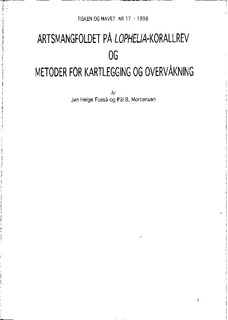Artsmangfoldet på lophelia-korallrev og metoder for kartlegging og overvåking
Research report
Permanent lenke
http://hdl.handle.net/11250/113675Utgivelsesdato
1998Metadata
Vis full innførselSamlinger
- Fisken og havet (1958- ) [700]
Sammendrag
The report presents an overview of all species identified from Lophelia reefs in Mid-Norway.
The results are based on analyses of material collected with ROV (Remote Operated Vehicle),
triangular dredge, van Veen grab and gravity corer. Results from the different gears are compared
to determine the sarnpling properties of the gears to deside upon which combination of gears and
methods are the most appropriate for the study of the fauna on Lophelia reefs.
The accompanying fauna is very rich in species, but few species are exclusively found on the
reefs. In total 362 taxa were identified among which 18 species are new to the studied area and
one species, the bryozoan Anarthropoda monodon, is new to Norway. The results of the present
investigation were compared with those of three earlier studies in the North-East Atlantic. In the
four studies a total of 744 species were identified, but with only 15 species in cornmon. This indicates
that the number of species associated with the reefs are much higher than described so
far. The results also show that the fauna of the reefs on the continental shelf differs compared to
that of the coast and fjords. This is especially evident within the Anthozoa, Amphipoda, Bryozoa
and Tunicata.
Number of species and individuals in a samle were quite different between gears, but the average
number of individuals per 100 g corals was comparable between triangular dredge and grab. The
differences may thus be explained by the difference in the quantity of corals in the samples in
addition to the effect of age and condition (dead or alive) of the corals. Lophelia reefs are a structurally
complex habitat and traditional methods for samling the bottom are probably not suitable
for monitoring tempora1 changes of the reef fauna. Video and photographic sampling of fixed
areas will probably give better indications on changes in the macrofauna and the condition of the
reefs. We recornmend to use a grab to describe the macrofauna because it effectively samples the
species and damages less corals than dredge. We als0 recommed to equip the grab with a
videocamera to ihprove the sampling precition. For extensive mapping and monitoring of reefs,
multibeam echosounder in combination with an UUV (Unthethered Underwater Vehicle) may be
the solution.NORSK SAMMENDRAG:
Rapporten presenterer en oversikt over arter som er funnet på Lophelia-rev i midt-Norge.
Resultatene er basert på analyser av materiale innsamlet med ROV (fjernstyrt miniubåt),
trekantskrape, grabb og gravity corer (kjerneprøvetaker). Resultater fra de ulike redskapstypene
er sammenliknet for å vurdere hvordan de forskjellige innsamlingsmetodene utfyller hverandre
og hvilken kombinasjon av redskap som er best egnet for unders~kelsera v faunaen på Lopheliarev.
Faunaen på Lophelia-rev er artsrik, men inneholder få arter som ikke også finnes på andre
substrater eller bunntyper. Totalt ble det funnet 362 taxa i prøvene. 18 av artene er ny for det
undersøkte området og en art, mosdyret Anarthropoda monodon, er nytt for Norge. Resultatene
er sammenliknet med 3 tidligere undersøkelser i det nordøstlige Atlanterhavet. Av totalt 744 arter
er bare 15 felles for disse unders~kelseneD. ette tyder på at antall arter tilknyttet revene er
adskillig høyere enn hittil beskrevet. Resultatene viser også at faunaen på revene ute på
kontinentalsokkelen er forskjellig fra den vi finner langs kysten og i fjordene. Dette er spesielt
tydelig for gruppene koralldyr (Anthozoa), amphipoder (Amphipoda), mosdyr (Bryozoa) og
sekkedyr (Tunicata).
Antall arter og individer i prøvene varierte mye avhengig av hvilket redskap som ble brukt, men
gjennomsnittlig antall individer per 100 g korall var relativt likt for trekantskrape og grabb.
Forskjellene kan således delvis forklares av forskjellige prøvestørrelser, men alderen og
tilstanden ( død eller levende) av korallene er sannsynligvis også en viktig faktor. Lopheliarevene
er et strukturelt sett meget komplekst habitat, og bunnprøvetaking er antagelig en lite
egnet måte for overvåking av forandringer i faunasammensetning over tid. Video og fotografiske
undersøkelser av faste områder vil kunne gi bedre indikasjoner på forandringer i form av
sammensetning av megafauna og størrelse og form av korallkolonier. For å undersøke
sammensetningen av makrofauna er grabb det beste redskapet, både i kraft av god fangstevne og
lite korallknusing. Vi anbefaler også at et videokamera blir satt på grabben for å øke presisjonen.
Til ekstensiv kartlegging og overvåkning kan flerstråle-ekkolodd fra kabelløs miniubåt på sikt bli
en effektiv metode.
Utgiver
Havforskningsinstituttet.Serie
Fisken og havetNr.17 - 1998
